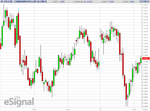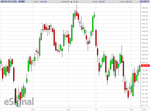Yamato
Legendary member
- Messages
- 9,840
- Likes
- 246
Thank you very much for sharing. As agreed, this is part of an effort to provide, aside from the signal, moral support to one another from the entering part to the exiting part of a trade. As discussed via private messages, I have a tendency to enter too easily and to exit too quickly when it's profitable and too slowly (or not at all) when it's unprofitable.
Regarding the signal, I see that CAD is oversold...

... although not as oversold as when I decide to go short on it. But my profitability is non-existent and I trust your analysis.
From my own experience of back-testing trading systems (and building profitable systems on this very concept), I should add that equity indexes tend to rise from Wednesday to Friday, and so do the currencies against the dollar, so this would speak against the trade, in general, but as I said, I rely on your analysis.
...
I just saw all the details you added, and by no means are they polluting my thread. To the contrary, the quality of your work is much higher than the quality of my work.
Thanks for sharing these insights and details about your strategy. I was never able to find a way to back-test volume profitably and I don't know about Sam Seiden's strategy yet, but if they work, I am willing to bet money on your signal, especially because I'd lose it anyway with my own trading.
At the same time, I will show you my ideas and see what you think of them. In the future because this last one is not worth your time. I simply went long the JPY because it had been falling for 13 straight weeks. And in fact this has been the rationale for most of my trades until now.
Regarding your reasoning for your volume analysis, which you added in your latest edit of the post, it sounds wise and I am intrigued by it, despite the fact that my own analysis of volume has always failed, and lately TWS won't even show me the volume anymore. A good point to raise at this is which volume is valuable data, and which isn't. Or is the volume on any instrument a valid data for analysis? For example, future, forex, ETF...? Are they all equally good sources of volume data?
And I am not just talking about a potentially problematic difference between thin and thick volume, because even two markets with great liquidity could be traded by different sets of people, producing different types of volume.
Regarding the signal, I see that CAD is oversold...

... although not as oversold as when I decide to go short on it. But my profitability is non-existent and I trust your analysis.
From my own experience of back-testing trading systems (and building profitable systems on this very concept), I should add that equity indexes tend to rise from Wednesday to Friday, and so do the currencies against the dollar, so this would speak against the trade, in general, but as I said, I rely on your analysis.
...
I just saw all the details you added, and by no means are they polluting my thread. To the contrary, the quality of your work is much higher than the quality of my work.
Thanks for sharing these insights and details about your strategy. I was never able to find a way to back-test volume profitably and I don't know about Sam Seiden's strategy yet, but if they work, I am willing to bet money on your signal, especially because I'd lose it anyway with my own trading.
At the same time, I will show you my ideas and see what you think of them. In the future because this last one is not worth your time. I simply went long the JPY because it had been falling for 13 straight weeks. And in fact this has been the rationale for most of my trades until now.
Regarding your reasoning for your volume analysis, which you added in your latest edit of the post, it sounds wise and I am intrigued by it, despite the fact that my own analysis of volume has always failed, and lately TWS won't even show me the volume anymore. A good point to raise at this is which volume is valuable data, and which isn't. Or is the volume on any instrument a valid data for analysis? For example, future, forex, ETF...? Are they all equally good sources of volume data?
And I am not just talking about a potentially problematic difference between thin and thick volume, because even two markets with great liquidity could be traded by different sets of people, producing different types of volume.
Last edited:





